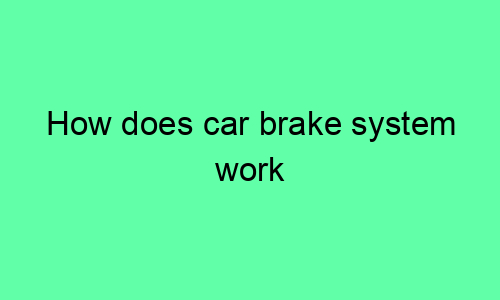## How Does a Car Brake System Work?
The car brake system is a crucial part of any vehicle, and it is responsible for slowing down or stopping the car when the driver applies pressure to the brake pedal. The brake system is a complex assembly of components that work together to create the necessary friction to slow down or stop a car, and it is essential for the safety of both the driver and passengers.
## The Different Types of Car Brake Systems
There are three main types of car brake systems:
* **Hydraulic brake systems** use a hydraulic fluid to transmit the force from the brake pedal to the brake pads. This is the most common type of brake system used in cars today.
* **Mechanical brake systems** use a mechanical linkage to transmit the force from the brake pedal to the brake pads. This type of brake system is less common than hydraulic brake systems, but it is still found in some older cars.
* **Air brake systems** use compressed air to transmit the force from the brake pedal to the brake pads. This type of brake system is commonly used in heavy-duty vehicles, such as trucks and buses.
## The Components of a Car Brake System
The main components of a car brake system include:
* **Brake pedal** – The brake pedal is what the driver presses to apply the brakes.
* **Master cylinder** – The master cylinder is a hydraulic pump that converts the force from the brake pedal into hydraulic pressure.
* **Brake lines** – The brake lines are a set of tubes that carry the hydraulic fluid from the master cylinder to the brake calipers.
* **Brake calipers** – The brake calipers are located on the wheels of the car. They contain the brake pads, which press against the brake rotors to create the friction necessary to slow down or stop the car.
* **Brake rotors** – The brake rotors are discs that are attached to the wheels of the car. They rotate with the wheels, and the brake pads press against them to create the friction necessary to slow down or stop the car.
## How a Car Brake System Works
When the driver presses the brake pedal, the force is transmitted through the brake lines to the brake calipers. The brake calipers then apply the brake pads against the brake rotors, creating friction that slows down or stops the car. The amount of friction created is determined by the amount of force applied to the brake pedal.
## The Importance of Regular Brake Maintenance
The brake system is a critical safety component of any car, and it is important to have it inspected and maintained regularly. Regular brake maintenance can help to prevent brake problems, and it can also help to extend the life of the brake components. Some of the most common brake maintenance tasks include:
* **Checking the brake fluid level** – The brake fluid level should be checked regularly, and it should be topped off if it is low.
* **Inspecting the brake pads** – The brake pads should be inspected regularly, and they should be replaced when they are worn down.
* **Inspecting the brake rotors** – The brake rotors should be inspected regularly, and they should be replaced if they are warped or damaged.
* **Lubricating the brake components** – The brake components should be lubricated regularly, to help prevent them from rusting and seizing up.
By following these simple maintenance tips, you can help to keep your car’s brake system in good working order, and you can help to prevent brake problems.






